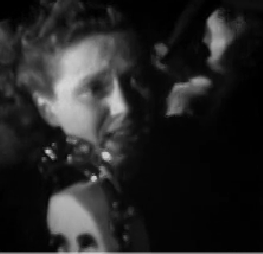“La Règle du Jeu” (The Rules of the Game) is a 1939 French film directed by Jean Renoir. Set on the eve of World War II, it presents a scathing critique of the French upper class through a story of romantic entanglements and social dynamics at a country estate. The film exposes the shallow and hypocritical nature of its characters through a blend of tragedy and comedy. Its complex narrative and sophisticated cinematography contribute to its status as one of the greatest films in the history of cinema. Despite facing initial criticism and censorship, “La Règle du Jeu” has since gained widespread acclaim for its exploration of human nature, social class, and the breakdown of societal order.
The Radio-Reporter in “La Règle du Jeu” (Lise Élina) is the first speaker in the entire film. The significance of the first speaker in a film lies in its ability to capture the audience’s attention and create a strong initial impression. It can create an emotional resonance, intrigue, or suspense that draws viewers into the story’s world and encourages them to invest in the characters and their journeys. The first speaker often sets the stage for the narrative arc, providing a glimpse of the overarching conflicts and motivations that will drive the characters’ actions and decisions.
The Radio-Reporter embodies a sense of modernity and independence that contrasts with the traditional roles typically assigned to women during the time period. Her involvement in the public sphere through her work as a reporter challenges traditional gender norms, highlighting the evolving opportunities for women to participate in professional and intellectual pursuits. This portrayal underscores the growing presence of women in the public domain and their increasing contribution to shaping public discourse. Will Straw’s work suggests that even seemingly peripheral characters play a crucial role in shaping the overall narrative and cultural discourse. The Radio-Reporter could represent the media’s influence in shaping public opinion and perpetuating societal norms, reflecting the larger theme of the power dynamics at play in the film. Despite her professional competence, she may encounter condescension or dismissiveness from certain male characters. This is seen when she is being pushed and shoved in-between the crowd of men. This incident can reflect the entrenched gender hierarchies prevalent in the film’s setting. Her experiences underscore the challenges faced by women seeking to establish themselves in male-dominated fields, shedding light on the complexities of gender relations and societal expectations.
Works Cited
Brooks, Charles William. “Jean Renoir’s The Rules of the Game .” JSTOR, Duke University Press, autumn 1971, www.jstor.org/stable/285986.
Straw, Will. “Introduction.” Screen, vol. 52, no. 1, 2011, pp. 78–81, https://doi.org/10.1093/screen/hjq057.
The Rules of the Game. Directed by Jean Renoir, Nouvelles Éditions de Films, 1939.

Provide Feedback